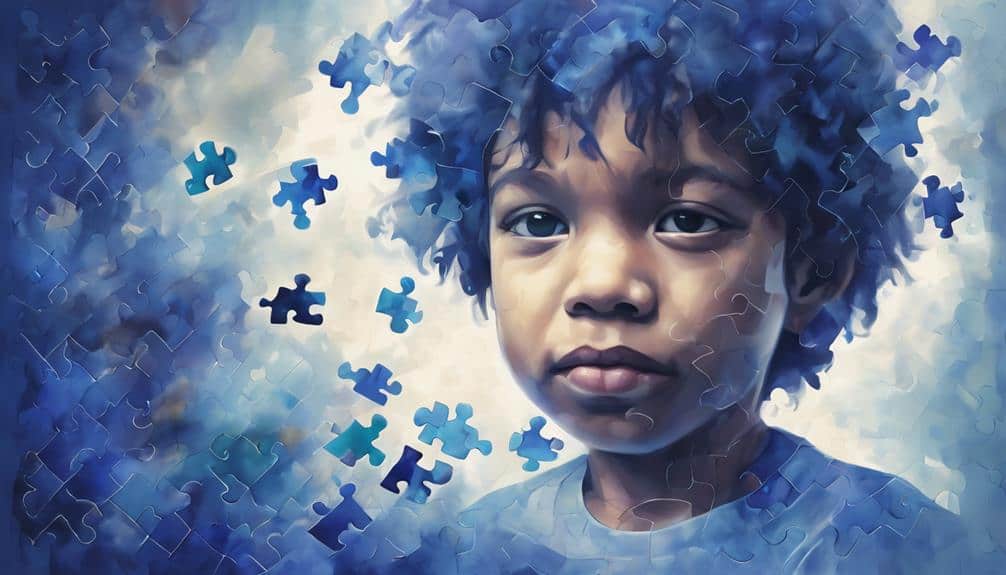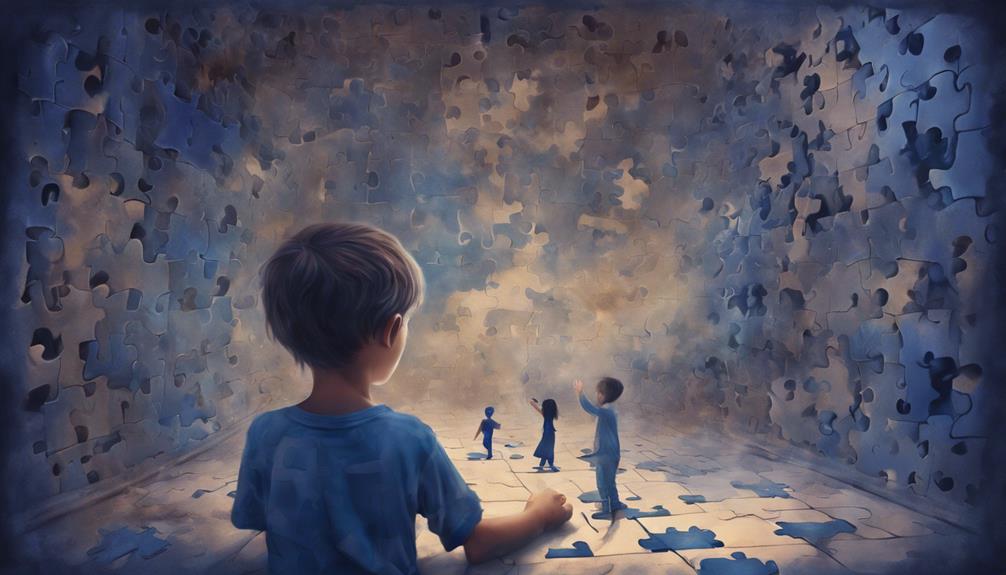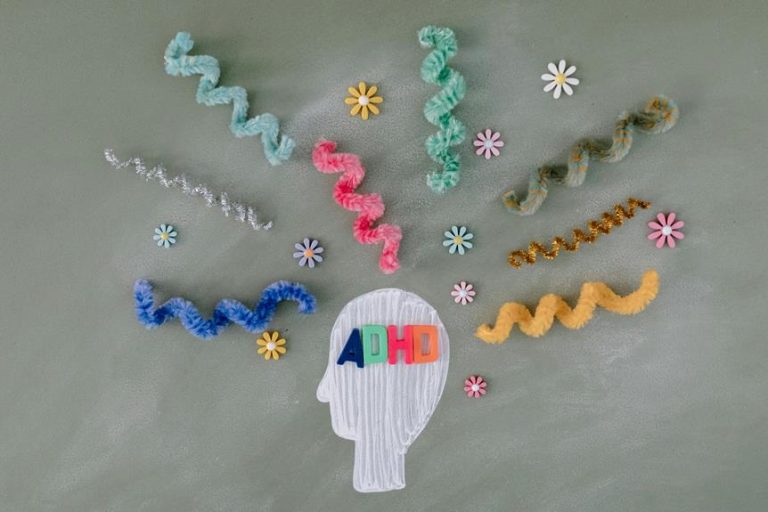Indigo Child Autism
Having heard about Indigo Child Autism, I found myself intrigued by the merging of indigo children's unique characteristics with autism spectrum traits. The idea of these two concepts intertwining raises questions about how we perceive and support children who exhibit such dual traits.
As I explored this topic further, I discovered a complex interplay between the attributes of indigo children and the challenges faced by those with autism spectrum disorders. Understanding the nuances of Indigo Child Autism could offer valuable insights into how we approach diagnosis and intervention strategies for these exceptional individuals.
Key Takeaways
- Indigo children exhibit unique traits overlapping with autism.
- Diagnosis necessitates expert assessment due to complex characteristics.
- Tailored interventions combining approaches for distinct needs.
- Research emphasizes understanding, unique treatments, and holistic support.
Characteristics of Indigo Children

Indigo children possess a unique blend of self-awareness and purpose that sets them apart from their peers. These children are often characterized by their high IQ, empathic nature, and strong-willed personalities. Their innate spirituality and intuitive abilities contribute to their special aura. Indigo children exhibit a depth of understanding and insight that goes beyond their years.
Diagnosing indigo children can sometimes be challenging for parents, as some may attribute their children's unique traits to being indigo rather than considering conditions like autism. This distinction is vital because while indigo children may share some characteristics with those on the autism spectrum, they're fundamentally different.
Understanding the nuances of indigo children is essential to provide them with the support and guidance they need to thrive. Recognizing their distinct qualities and embracing their individuality can help foster a nurturing environment where they can fully express their potential. It's important to approach the diagnosis of indigo children with care and consideration, respecting their uniqueness while also addressing any specific needs they may have.
Overlapping Traits With Autism Spectrum Disorder

Exploring the similarities between individuals classified as indigo children and those diagnosed with Autism Spectrum Disorder involves recognizing shared traits that can sometimes blur the lines between the two distinctions.
Indigo children and individuals with ASD may exhibit overlapping characteristics, including sensitivity, high intelligence, and a strong sense of purpose. Both groups often face challenges in social interactions, communication, and sensory sensitivities.
It isn't uncommon for parents to initially attribute certain behaviors to their child being an indigo before considering or receiving a formal ASD diagnosis. Understanding the differences between the spiritual concept of indigo children and the clinical diagnosis of Autism Spectrum Disorder is important to provide appropriate support and interventions tailored to the specific needs of each individual.
Recognizing these shared traits can lead to a more nuanced understanding of both indigo children and individuals with ASD, fostering empathy and effective support strategies.
Challenges Faced by Indigo Children With Autism

Exploring the world as an indigo child with autism can present a unique set of challenges. From heightened sensory experiences to difficulties in social interactions, these individuals often find themselves caught between two worlds.
Balancing these contrasting traits requires a deep understanding and tailored support to help them thrive.
Unique Sensory Experiences
Heightened sensory sensitivity poses significant challenges for children with autism who identify as Indigo, impacting their daily interactions and experiences. These unique sensory experiences can lead to sensory overload, making bright lights, loud noises, or strong smells overwhelming.
Difficulty in processing sensory information may result in meltdowns or shutdowns, affecting their ability to function in various environments. Sensory integration therapy plays a crucial role in helping indigo children with autism regulate their sensory experiences and cope better with their surroundings.
Creating supportive environments that understand and cater to the heightened sensitivity of these individuals is essential for their overall well-being and development.
Social Interaction Difficulties
Indigo children with autism often face significant challenges in social interactions due to their struggles in understanding and interpreting social cues and norms. These difficulties can manifest in various ways, such as finding it challenging to make and sustain friendships, interpret non-verbal cues like facial expressions, and engage in reciprocal communication.
The unique combination of indigo traits and autism can create distinct social hurdles that necessitate tailored support and comprehension. Some indigo children with autism may feel more comfortable in solitude or prefer interactions with individuals who share similar interests. Recognizing the specific needs and obstacles faced by these individuals is crucial for providing effective interventions and nurturing their social development.
Identifying Indigo Children With Autism

Identifying children who exhibit traits of both indigo characteristics and autism can be a complex and nuanced process requiring careful observation and evaluation by trained professionals. It's essential to distinguish between the unique characteristics of indigo children and the diagnostic criteria for autism to provide appropriate support and interventions.
Here are some key points to ponder:
- Observation: Professionals need to closely observe a child's behaviors and interactions to identify whether they align more with indigo characteristics or autism symptoms.
- Professional Diagnosis: Seeking a formal diagnosis from qualified healthcare providers or specialists is crucial to understand a child's needs accurately.
- Avoiding Labels: While recognizing the traits of indigo children, it's essential not to overshadow the importance of addressing the specific challenges that come with an autism diagnosis.
- Tailored Interventions: Developing personalized interventions that take into account both the indigo traits and autism-related needs can help support the child effectively.
Support and Interventions for Dual Traits

Understanding the unique challenges faced by parents of children exhibiting dual traits of being an indigo child and having autism is important in providing effective support and interventions tailored to their specific needs. Parents maneuvering this journey should seek professional guidance from specialized experts well-versed in both indigo traits and autism.
By recognizing the intuitive abilities and sensory sensitivities of these children, caregivers can develop personalized strategies to support their holistic development. It's vital to adopt a holistic approach that combines traditional autism therapies with methods that align with the unique characteristics of indigo children.
Creating a nurturing environment that embraces and celebrates these dual traits can help children with indigo traits and autism thrive. By fostering acceptance and understanding, parents can empower their children to harness their strengths and overcome challenges, ultimately enabling them to reach their full potential.
Research and Future Directions

As we ponder the research findings on autism and future treatment approaches, it becomes vital to explore the potential overlap between characteristics of indigo children and symptoms of autism.
Research Findings on Autism
In exploring research on autism, it's essential to investigate the intricate interplay of genetic, environmental, and neurological factors shaping our understanding of this complex neurodevelopmental disorder.
When considering autism and indigo children, it's important to emphasize that scientific evidence doesn't support a link between the two. The characteristics associated with indigo children aren't recognized by the medical community as indicators of autism.
Autism, characterized by challenges in social communication and repetitive behaviors, requires evidence-based assessments and intervention strategies. Research in this field emphasizes early detection and tailored support for individuals with autism spectrum disorder.
The focus remains on understanding the distinct nature of autism and providing effective interventions based on empirical findings.
Future Treatment Approaches
Considering the limited research on the overlap between indigo children and autism spectrum disorder, future treatment approaches may involve tailored interventions addressing both sets of traits. Understanding the unique characteristics of indigo children within the context of autism is vital for developing targeted therapies. Collaborative studies are needed to explore the neurological differences and similarities between indigo children and individuals with autism, paving the way for more effective interventions.
Integrating holistic approaches with evidence-based strategies can provide thorough support for indigo children with autism, recognizing their specific needs and strengths. By combining insights from both the indigo children phenomenon and autism spectrum, we can create more inclusive and personalized treatment plans that cater to the diverse needs of these children.
Frequently Asked Questions
What Are the Traits of an Indigo Child?
Traits of an indigo child encompass intuitive empaths, creative thinkers, spiritual connection, unique perspectives, energy sensitivity, emotional intelligence, psychic abilities, empathic healing, intense emotions, and old souls. These qualities shape their extraordinary essence and impact.
What Are the Signs of a Child With Autism?
Early intervention is essential in recognizing signs of autism in children. Social communication struggles, repetitive behaviors, sensory sensitivities, speech delays, and challenges with emotions are common. Behavioral therapy, parental support, and understanding nonverbal cues aid in cognitive development.
Are Indigo Children Sensitive?
Yes, I am sensitive to emotional intelligence, energy healing, psychic abilities, intuition development, crystal children, spiritual connection, sensory overload, telepathic communication, empathic nature, and mind-body connection. My heightened awareness enhances my unique traits.
Can a Child Have Both Autism and Adhd?
Yes, a child can have both autism and ADHD. The overlapping symptoms can create challenges, but tailored treatment options, parenting strategies, and educational accommodations can help. Understanding the co-occurring conditions is important for effective support.
Conclusion
In the complex tapestry of Indigo Child Autism, the intertwining threads of intuition and intelligence meet the challenges of autism spectrum disorder. Maneuvering this unique intersection requires a delicate balance of understanding and support.
By acknowledging both the strengths and struggles of these children, we can pave the way for tailored interventions and a brighter future. Embracing the duality of indigo traits and autism realities, we can create a path towards empowerment and growth.







